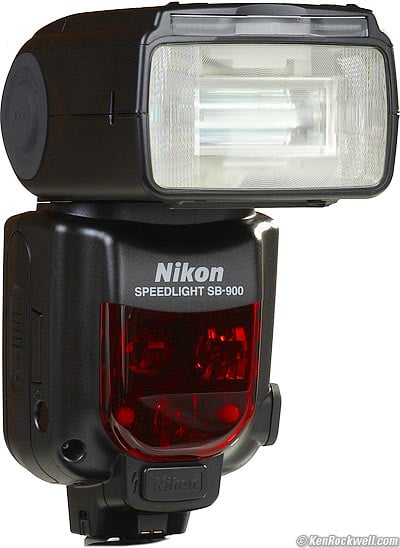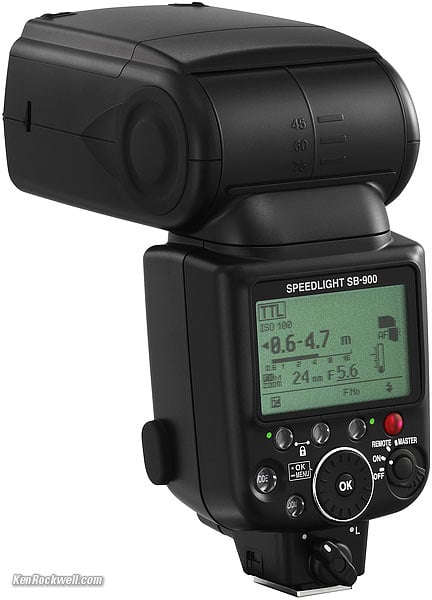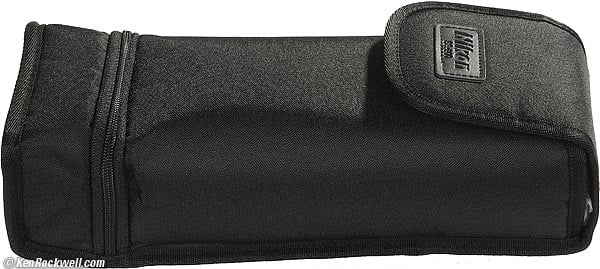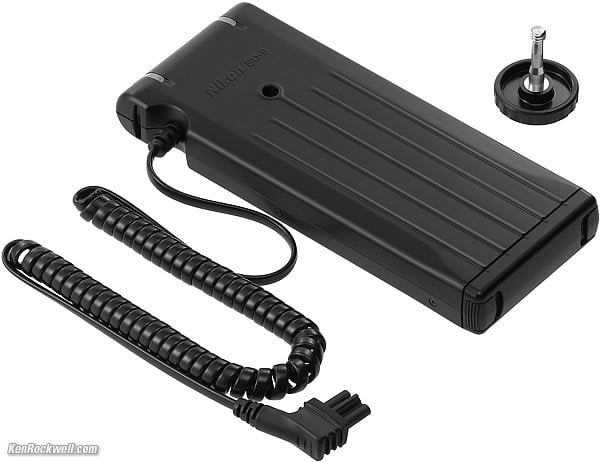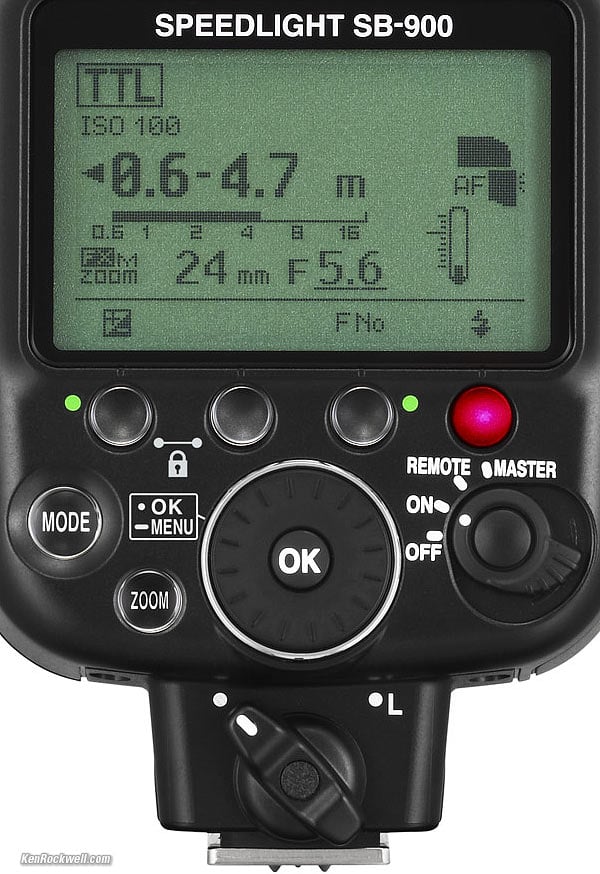Home Donate New Search Gallery Reviews How-To Books Links Workshops About Contact Nikon SB-900 Nikon SB-900. enlarge. I'd get mine at Adorama, Amazon or Ritz. It helps me keep adding this site when you get yours from these links, thanks! Ken.
August 2008 More Nikon Reviews How to Use Wireless Flash Control.
Intro Specs Performance Recommendations Another flash? Why should I care? When I heard it costs $500, I really wanted to know. (It's down to $470 as of August, 2008.) If you don't want to read the rest of this review, I'll cheat and let you know that I prefer the $110 SB-400, and if I want a big flash, I prefer the $185 SB-600. This SB-900 is more of a video game than a flash. The SB-900 is for full-time wedding and news pros, which I'm not. The smaller flashes work just as well, are smaller, and a fraction of the price. I got my hands on one, and my first thoughts are that the high price is for all the gizmos and things that just get in the way of ever being able to figure it out and take a picture. Opening the box is impressive. There are all sorts of filter sets, stands and manuals included. Once you dig through those (you have to grab a handle which pulls them all out of the way), you find a nice nylon case holding the SB-900 with a weird bottom section. The bottom section holds an included Sto-Fen style diffuser. The SB-900's LCD is big, but the lettering from the dot-matrix panel is thin, tiny and weak. It's not easy to see what's going on. I prefer the bolder graphics of the SB-600's dedicated (not dot-matrix) LCD. Want to set exposure compensation? Press a button, drive some knobs and squint. On an SB-600, all you have to do is press a dedicated button and look at the big numbers. There are so many modes that it's tougher to get the mode you want. There are menus and options out to gazoo. If you like gadgets, you'll love the SB-900. If you just want to take a picture, it's the last thing I'd get. Unlike any other Nikon flash, it has menus and firmware you can update, in case Nikon decides to add even more features you don't need. There are options to program your own menus. The best thing about the SB-900 is the dedicated rotary power switch. It just turns on; while the SB-600 and SB-800 require holding a button. A half-second holding a button is too long to wait when you're switching your flash on and off from shot to shot (the SB-400 also has a dedicated slide switch). The SB-900's ready light is too big and too bright. I prefer the one on the tiny SB-400, which is pointy enough to be visible in daylight, but small enough not to light up your face at night. The SB-900 ready light is too bright when seen from behind, but it's directional and less visible for the sides. The ready lights of the SB-400 and SB-600 are much more visible from the sides. It seems silly, but the SB-900 ready light is inferior. The SB-900 is Nikon's biggest flash yet. It's not unmanageable, but it's bigger then the SB-400, SB-600 or SB-800. The SB-900 is a flash for full-time newsmen and wedding shooters. It's a poor choice for general photography, for which no flash at all is best, and your built-in flash is usually perfect for daytime fill. If not, I prefer the SB-400 or SB-600 for their smaller size and faster controls.
Sales Features Here's what Nikon pitches to impress people: 1.) Crazy zoom range: 17mm - 200mm. This is a crock, see the Performance section below. 2.) Ability to screw-up the evenness of illumination, called "light patterns" by Nikon. You can have your choice of a hotspot, the normal mode, or a more even mode. This is also a crock as explained below. 3.) Faster recycle time, but look out for melted batteries! Nikon claims the SB-900 is 25% faster with 4-AAs than the SB-800 is with five AAs! My tests didn't impress me that much. 4.) Sadly what might have been a battery level display on the LCD is just measuring whether or not you can keep shooting, or if you've overheated the flash. 5.) Even more complexity and menus. This keeps Thom Hogan in business writing flash guides. I rarely bother to update firmware in my cameras, but now, you can do it in your flash! 6.) Comes standard with what we've done in Hollywood for decades: filters to match the color of the flash to ambient light. You then set your WB to the ambient light, and everything matches. I've done this with Rosco gels for years, taping them to my flash. Cooler is that if you use Nikon's light balancing filters, the newest cameras (D3 and D700) know what filter is on the flash. 7.) Bigger AF-assist beam to cover 51 focus points of the newer Nikons. 8.) A little more pivoting: up to -11º down, as well as +90º up and 180º left and right. 9.) Bigger and heavier than SB-800. It does all the things the other flashes do, like non-TTL Auto for use with every camera ever made and serve as a wireless slave or master wireless controller with newer cameras. But wait!
Compatibility Limitations The SB-900, like the SB-400, only works on the F6 and the newest digital cameras introduced since 2004 that use the newest i-TTL flash system. This is the big little secret that Nikon doesn't trumpet when it lists the SB-900 as an "i-TTL" flash. What Nikon doesn't publicize is that the SB-900 does not work in the traditional TTL mode of film cameras, nor does it work in the older d-TTL mode needed by the D100, D1X, D1H or D1. With these cameras, you have to use the primitive non-TTL Auto mode, just like a 1970s Vivitar 283. If you're shooting film, shoot the F6 (always a great idea), and if digital, the D70/x, D50, D40/x, D60, D80, D200, D300, D700, D2/H/X and D3 are all AOK. If you do use it on an older camera, the SB-600, SB-800 and every other flash Nikon has ever made will work perfectly in TTL mode, but not the SB-400 or SB-900. If you put the SB-900 on one of these other cameras, the SB-900 is smart enough to go in to A mode magically, instead of blinking at you in TTL. The gotcha is that you will need to remember to set and check the necessary apertures; you can't just fire it up and go as you can with other flashes on these slightly older cameras. Nikon SB-900. enlarge.
Specifications with commentary back to top Intro Specs Performance Recommendations Rated Guide Number (flash power): 131/40 in feet/meters at ISO 100, rated with zoom set to 35mm/FX in normal evenness mode. With all this hoopla, it's only one sixteenth of a stop brighter than the SB800, which has a GN of 125 in the same setting. Rated Recycle Time (full power): 4 seconds with alkalines, 2.3 seconds with NiMH. Rated Flashes at full power: 110 per set of alkalines, 190 per charge of 2,600 mAh NiMH. Swivel: 180º left or right, 90º up and 11º down. Useful Modes: TTL, Non-TTL auto, manual, wireless, FP sync. Games: Repeating flash (disco strobe mode), Auto Aperture, distance-priority manual. Power: 4 AA batteries. Size: 3.0 x 5.7 x 4.7" (78 x 146 x 118mm). (SB-800 is 2.8 x 5.0 x 3.6" (71 x 127 x 92mm).) Weight: 18.655 oz. (528.7g), measured with 4 Sanyo Eneloop AAs. Nikon specs 14.6 oz. (415g), empty. (SB-800 is 12.3 oz. (350g), empty.) Includes: AS-21 Speedlight Stand; SW-13H Diffusion Dome; SJ-900 Color Filter Set; SZ-2 Color Filter Holder; SS-900 Soft Case. SS-900 Case. Dig the bottom pocket for Nikon's included Sto-Fen thing. enlarge. Optional: SD-9 external battery holder ($190).
Nikon SD-9 battery holder. Made in: Japan. Introduced: 01 July 2008. Available: August 2008. Nikon Product Number: 4807.
Performance back to top Intro Specs Performance Recommendations All Nikon flashes light the subject as well. My personal favorite is the diminutive SB-400 because it's so portable, and because I can turn it off and on instantly with a slide switch instead of having to wait holding a pushbutton like on the SB-600 or SB-800. Thank goodness the SB-900 has a rotary power switch.
Nikon SB-900 LCD and controls, larger than actual size. Now we need menus for regular operation? Yikes! I prefer the least expensive Nikon "big" flash, the SB-600, because its sharp and bold custom direct-read LCD is much easier to read than the gray-on-gray dot-matrix LCDs of the SB-800 and SB-900. If you want an SB-900, be sure you can figure it out! I doubt anyone can. Compare it to the SB-600. Fewer options and controls always means it's faster and easier to get to what you really need to adjust. To set exposure compensation on the SB-900, you press the +/- button and spin the knob. That's easy, but reading the tiny numbers isn't. You're better off doing this from inside the camera. The SB-900 is big. It's for guys who don't mind a dorky flash sitting on top of their rig. The battery door is great, and its easy to know which way to insert them. By comparison, the SB-600 has the batteries arranged oddly. There is still no battery meter. Ni-MH cells die without warning. Flash Power and Recycling Times My flash meter tells me that this brand-new flagship SB-900 is only 2/3 stop more powerful than my several years-old inexpensive SB-600. Big deal. At full power, the SB-900 recycles more slowly than the SB-600 at full power. If I turn down the power of the SB-900 2/3 of a stop so it's pumping out equal power, the SB-900 recycles a little faster than the SB-600. A Mode (non-TTL) You can program any 1/3 stop, so you have limitless f/stop options. Normal flashes used to have on one or a few full-stop options. One shortcoming is that Nikon lets you set any 1/3 stop from f/1.4 to f/90, but forgot to let you use f/1.2, so you waste that ability on the 50mm f/1.2 AI-s. I suppose you could program a different ISO to trick it. I'd gladly trade f/90 for f/80 if I could get f/1.2 instead. LCD The LCD is big, but the the lettering is too small and too light. It's hard to read: you have to concentrate on it too much. The backlight is very good. It's a green-cyan EL panel. Remote Flash It takes a weird kind of guy to get excited by Nikon's wireless system. Wireless lighting with one remote flash is fun, and lighting is the very most important technical aspect of any photo. When it comes to more than one flash, that means I'm getting serious, and will use my studio strobes with umbrellas and real stands. I bought my entire studio setup, used, for about what this single flash sells for new. Now you know why Nikon pushes wireless flash. Green Reset Mode With all the ways you can screw up the settings, it's a Godsend that you can reset the SB-900 to where yo need it simply by holding both green buttons. Nutty Zoom Ranges The 17-200mm zoom range is a crock. The different "distribution patterns" are, too. The different distribution patterns really are just renaming the various zoom settings. I shoot my fisheye and 14mm FX lenses with other flashes' flip-down diffuser panels. The SB-600 has the same 14mm panel as does the SB-900, so no big deal here. I often shoot with my flash set to a longer focal length with ultrawide lenses, since in most situations I'm not shooting a blank wall, for which these panels are designed. When shooting with an ultrawide in a room, the sides of my photos are usually walls, floors and ceilings, which are closer to my flash than the subject in the middle. Thus I rarely use the ultrawide diffusers of most flashes, because they make the sides too light. The 200mm zoom setting is also a crock. The reason you'd want a 200mm zoom setting is if it concentrated the light well enough to give you extra shooting range. The SB-900's 200mm zoom setting gives only a 1/3 stop advantage over the 85mm setting of the SB-600. At their 35mm settings, the SB-900 is 2/3 of a stop more powerful than the SB-600. When tested with my flash meter, the big scary SB-900 set to 200mm was only one stop brighter at full output than the SB-600 set to at 85mm. Thus the fancy-dancy reflector system of the SB-900 is only good for an extra third of a stop. No, the SB-900 doesn't replace your Better Beamer. Recommendations back to top Intro Specs Performance Recommendations If you're a full-time newsman, paparazzi or wedding guy, you know you want this flash. If you're a gadget hound who had to have the first GPS, iPhone and PDA on your block, get this SB-900. You'll love it and it works very well. If you just want great photos, don't let me tell you not to get the SB-900, but I will tell you that you certainly don't need it. The SB-900 offers nothing significant over the SB-800, and isn't as easy to use as the SB-600. The other features are just fluff. The only significant advantage of the SB-900 over the SB-600 and SB-400 is that the SB-900 (and SB-800) have a built-in white card to provide a catch light when bounced. I use a white Post-It Note on the other flashes to do the same thing. Honestly, the only flash I ever carry is an SB-400, and my SB-600 is only used in my studio, set to manual, to trigger my pro system. If you're a studio shooter, you'd be an idiot to get one of these SB-900s. I paid the same $500 for a complete three-head used Novatron system. If you're a snapshooter, forget this big honking thing. Your camera's built-in flash is all you need for digital. If you want to bounce, I use the SB-400 myself, and with how well digital cameras work at high ISOs, I rarely use any flash. I use flash only to fill-in shadows in harsh outdoor light. If you're a serious hobbyist, you still don't really need an on-camera flash like we sometimes did back in the 1970s before film got fast. If you insist on having a big flash on-camera, go for the SB-600 instead. The SB-600 does everything anyone needs, without all the fluff features that get in the way on the SB-800 and SB-900.
PLUG I support my growing family through this website. If I just saved you $400, if you find this as helpful as a book you might have had to buy or a workshop you may have had to take, feel free to help me continue helping everyone. If you've gotten your gear through one of my links or helped otherwise, you're family. It's great people like you who allow me to keep adding to this site full-time. Thanks! If you haven't helped yet, please do, and consider helping me with a gift of $5.00. It also helps me keep adding to this site when you get your goodies through these links to Adorama, Amazon, B&H, Ritz, and J&R. I use them and recommend them all personally. Thanks for reading!
Ken |
Home Search Gallery How-To Books Links Workshops About Contact

